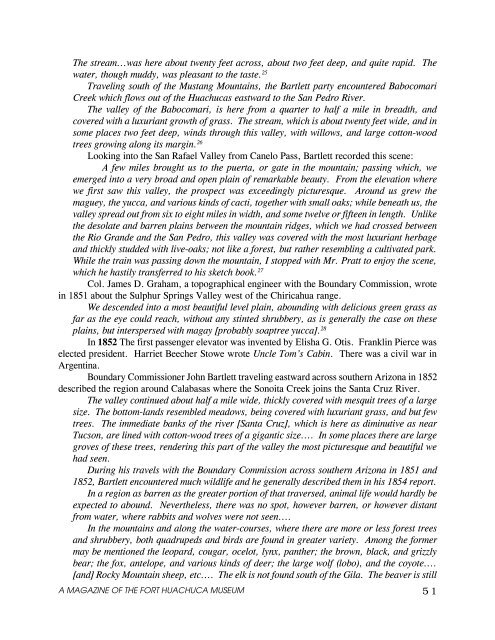Huachuca Illustrated - Fort Huachuca - U.S. Army
Huachuca Illustrated - Fort Huachuca - U.S. Army
Huachuca Illustrated - Fort Huachuca - U.S. Army
You also want an ePaper? Increase the reach of your titles
YUMPU automatically turns print PDFs into web optimized ePapers that Google loves.
The stream...was here about twenty feet across, about two feet deep, and quite rapid. The<br />
water, though muddy, was pleasant to the taste. 25<br />
Traveling south of the Mustang Mountains, the Bartlett party encountered Babocomari<br />
Creek which flows out of the <strong>Huachuca</strong>s eastward to the San Pedro River.<br />
The valley of the Babocomari, is here from a quarter to half a mile in breadth, and<br />
covered with a luxuriant growth of grass. The stream, which is about twenty feet wide, and in<br />
some places two feet deep, winds through this valley, with willows, and large cotton-wood<br />
trees growing along its margin. 26<br />
Looking into the San Rafael Valley from Canelo Pass, Bartlett recorded this scene:<br />
A few miles brought us to the puerta, or gate in the mountain; passing which, we<br />
emerged into a very broad and open plain of remarkable beauty. From the elevation where<br />
we first saw this valley, the prospect was exceedingly picturesque. Around us grew the<br />
maguey, the yucca, and various kinds of cacti, together with small oaks; while beneath us, the<br />
valley spread out from six to eight miles in width, and some twelve or fifteen in length. Unlike<br />
the desolate and barren plains between the mountain ridges, which we had crossed between<br />
the Rio Grande and the San Pedro, this valley was covered with the most luxuriant herbage<br />
and thickly studded with live-oaks; not like a forest, but rather resembling a cultivated park.<br />
While the train was passing down the mountain, I stopped with Mr. Pratt to enjoy the scene,<br />
which he hastily transferred to his sketch book. 27<br />
Col. James D. Graham, a topographical engineer with the Boundary Commission, wrote<br />
in 1851 about the Sulphur Springs Valley west of the Chiricahua range.<br />
We descended into a most beautiful level plain, abounding with delicious green grass as<br />
far as the eye could reach, without any stinted shrubbery, as is generally the case on these<br />
plains, but interspersed with magay [probably soaptree yucca]. 28<br />
In 1852 The first passenger elevator was invented by Elisha G. Otis. Franklin Pierce was<br />
elected president. Harriet Beecher Stowe wrote Uncle Tom’s Cabin. There was a civil war in<br />
Argentina.<br />
Boundary Commissioner John Bartlett traveling eastward across southern Arizona in 1852<br />
described the region around Calabasas where the Sonoita Creek joins the Santa Cruz River.<br />
The valley continued about half a mile wide, thickly covered with mesquit trees of a large<br />
size. The bottom-lands resembled meadows, being covered with luxuriant grass, and but few<br />
trees. The immediate banks of the river [Santa Cruz], which is here as diminutive as near<br />
Tucson, are lined with cotton-wood trees of a gigantic size.... In some places there are large<br />
groves of these trees, rendering this part of the valley the most picturesque and beautiful we<br />
had seen.<br />
During his travels with the Boundary Commission across southern Arizona in 1851 and<br />
1852, Bartlett encountered much wildlife and he generally described them in his 1854 report.<br />
In a region as barren as the greater portion of that traversed, animal life would hardly be<br />
expected to abound. Nevertheless, there was no spot, however barren, or however distant<br />
from water, where rabbits and wolves were not seen....<br />
In the mountains and along the water-courses, where there are more or less forest trees<br />
and shrubbery, both quadrupeds and birds are found in greater variety. Among the former<br />
may be mentioned the leopard, cougar, ocelot, lynx, panther; the brown, black, and grizzly<br />
bear; the fox, antelope, and various kinds of deer; the large wolf (lobo), and the coyote....<br />
[and] Rocky Mountain sheep, etc.... The elk is not found south of the Gila. The beaver is still<br />
A MAGAZINE OF THE FORT HUACHUCA MUSEUM<br />
51
















